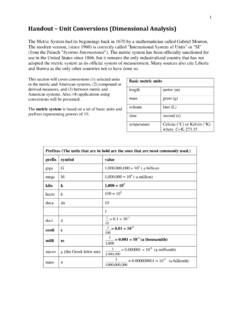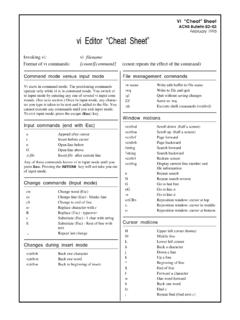Transcription of The Word 2007/2010 Equation Editor
1 Use of the Equation Editor Steven A. Jones Last Updated: February 13, 2013 Louisiana Tech University The Word 2007 / 2010 Equation Editor Contents The Word 2007 / 2010 Equation Editor .. 1 When the Equation Editor Should Be Used .. 1 Why the Equation Editor Should Be Used .. 1 How to Enter the Equation Editor Quickly .. 2 Equation display modes .. 2 Insertion of Single Symbols .. 3 Insertion of Spaces .. 3 Grouping and Brackets .. 4 Superscripts and Subscripts .. 4 Division and Stacking .. 4 Parentheses size control with \phantom and \smash .. 6 Square Roots and Higher Order Roots .. 7 Integrals, Products and Sums .. 7 Function Names .. 7 Other Font Changes .. 8 Accent Marks, Overbars, Underbars, Above and Below .. 8 Greek Alphabet .. 9 Hebrew Characters .. 9 Equation Numbers .. 9 Symbol that Lack Keywords.
2 10 References .. 11 When the Equation Editor Should Be Used The Equation Editor should be used to format your equations . In some cases you can use simple Word commands, such as superscript (<control>+) and subscript (<control>=) to format simple variables, as when you wish to say, L1 is the length of the beam, but in doing so, you should pay attention to the font in which the variable is displayed. For example, variables should be formatted in italic font, while function names and units of measure should be in regular font. (It is often easiest to use a shortcut key, as described below, to jump into the Equation Editor , even if you are simply typing a variable name). Why the Equation Editor Should Be Used Some equations will be nearly impossible to represent without this Editor . Others will simply look unprofessional.
3 Compare the following: dy ax2 + bx + c --- = - -------------- sin( ) dx (x )2 = 2+ + ( )2sin The second form looks better, requires about a third of the time to create with the Equation Editor , and is far easier to modify. You can save substantial time if you become familiar with the shortcut commands within the Equation Editor . This document describes the use of the Editor available in Word 2007 . This environment differs from the keystroke-based Editor that was available in previous versions of Word or in Mathtype. Its syntax is similar to that of Te a typesetting program that pre-dates Microsoft Word. 1 Use of the Equation Editor Steven A. Jones Last Updated: February 13, 2013 Louisiana Tech University How to Enter the Equation Editor Quickly The quickest way to enter the Equation Editor is the shortcut key <alt>= (hold down the <alt> key while you type = ).
4 You can also click on Equation under the Insert tab, but this sequence can become cumbersome when you are setting a large number of equations or defining multiple variables within text. The need to move your hands from the keyboard to the mouse (or mouse pad) slows your typing. You now have no excuse not to use the Equation Editor on a casual basis. It is only one keystroke away. While in the Equation Editor , you can use various symbols and keywords instead of the more cumbersome menu bar. A more complete description of the codes used by the Equation Editor and the syntax and philosophy behind it is given by Sargent [1]. Single characters, such as _, ^ and / that have special meanings. Keywords such as \alpha that will be translated to symbols (in this case, ). Keywords such as \sqrt and \overbrace will modify expressions that are correctly grouped.
5 Note: Spaces that you type are important to the Equation Editor because they tell the Editor when it is time to translate a part of the Equation you are typing. Where it is necessary for clarity in this document, a space will be represented by the sequence <sp>. Equation display modes If you click on an Equation , it will become highlighted, as shown in Figure 1. When you then click on the blue downarrow at the lower right, five options appear. Save as new allows you to keep the Equation as a building block, which makes it available from the Insert ribbon. Professional means that the Equation should be displayed as a formatted Equation . Linear means to show the Equation in its raw form, similar to the way that the Equation was typed, but with some of the typed codes translated into special characters.
6 Display means that the Equation will be formatted in a way that is appropriate for an Equation between paragraphs. Inline means that the Equation will be formatted in a way that is appropriate for an Equation within a paragraph. Inline equations tend to be more compressed than displayed equations . Figure 1: The appearance of an Equation . 2 Use of the Equation Editor Steven A. Jones Last Updated: February 13, 2013 Louisiana Tech University Insertion of Single Symbols Keywords can be used to quickly insert a limited number of frequently used symbols. Keywords are case-sensitive ( , \rightarrow is different from \Rightarrow). If you need a single symbol that does not appear on this list, see the section Symbol that Lack Keywords. To Insert Type Or To Insert Type Or \infty \hbar \rightarrow \-> \leftarrow \uparrow \downarrow \nearrow \nwarrow \searrow \swarrow \leftrightarrow \updownarrow \Rightarrow \Leftarrow \Uparrow \Downarrow \partial \nabla \le <= \ge >= \ll << \gg a\times b ( ) ( ) f(t)\otimes g(t) a\cdot b a\odot b x\oplus y a\ominus y a\mapsto b \hookrightarrow.
7 A\dots b a\cdots b a\bot b a\top b A\bigcap B A\bigcup B A\bigsqcup B A\biguplus B a\star b \forall \in \exists \bigwedge \bigvee \ne \approx \equiv \cong \sim \simeq \bowtie \box \subset \emptyset ~= \therefore \because \pm +- \mp -+ \angle \propto 22 C 22 \degree C Insertion of Spaces Because spaces have special meaning in the Equation Editor , and because the Equation Editor usually handles spacing appropriately, the spacebar cannot usually be used to add spaces within equations . However, spaces can be inserted with the following keywords: ( Keywords \medsp, \thicksp and vthicksp also exist, but \ medsp is a not-so-useful synonym for no space at all, and \thicksp and \vthicksp are synonyms for \thinsp).
8 \hairsp a small space xx \thinsp a wider space xx 3 Use of the Equation Editor Steven A. Jones Last Updated: February 13, 2013 Louisiana Tech University Grouping and Brackets The Equation Editor causes brackets (such as [], {} and ( )) to grow to the size of the expression within them. However, parentheses are the grouping character and will not display when used as such. To force parentheses to display, you must double them. To prevent brackets from being reformatted, precede them by the \ character. Some examples follow. To Display Type Comments [a/b] The / command for fractions is described in a later section. {a/b} (a/b) Parentheses display. +1 a/(b+1) Parentheses used for grouping do not display. ( +1) a/((b+1)) Double parentheses display.
9 { a\atop b \close y The \close keyword completes the opened brace. The \atop command is described in a later section. | | + |(a|b|f)/(c+d)| The parentheses are, again, used for grouping. | | + |a|b|f/(c+d)| =[ ] y=\[<sp>a/b<sp>\] Backslashes prevent [ and ] from growing. \norm a\norm Superscripts and Subscripts The _ and ^ keys are used to insert superscripts and subscripts. Grouping is important because it distinguishes between 2nF and 2nF. Terms can be grouped by enclosing them in parentheses, where the parentheses themselves do not print. Some simple examples follow: To Display Type Notes x_i\times<sp>y^n The spacebar <sp> is needed. +1 x^(i+1) The parentheses do not show. See grouping. x_i^n +1 F_n^(k+1) +1 F_(n^(k+1)) All of the parentheses are needed.}
10 09 (_0^9)H Division and Stacking Use the / character for division. The Equation Editor will reformat the expression to place the numerator above the denominator. To prevent vertical buildup of the fraction, use \/ instead of / alone. As with superscripts and subscripts, you can use parentheses to group expressions into a numerator and denominator. Examples follow: 4 Use of the Equation Editor Steven A. Jones Last Updated: February 13, 2013 Louisiana Tech University To Display Type Comments ab a/b abcd++ (a+b)/(c+d) Parentheses do not print. ()abcd++ ((a+b))/(c+d) The double parentheses force the single parentheses to print in the numerator. ( )1/ 2abncdfx e++++ ((a+b)/(c+d) + n)/(f(x)+e^(1\/2))<sp> The / is preceded by \ in the exponential to provide a horizontal fraction (1/ 2 instead of 12).








